Rainbow Row is the name for a series of thirteen colorful historic houses in Charleston, South Carolina. The houses are located north of Tradd St. and south of Elliott St. on East Bay Street, that is, 79 to 107 East Bay Street. The name Rainbow Row was coined after the pastel colors they were painted as they were restored in the 1930s and 1940s. It is a popular tourist attraction and is one of the most photographed parts of Charleston.

The large, neoclassical Simmons-Edwards House is a Charleston single house built for Francis Simmons, a Johns Island planter, about 1800. The house, located at 14 Legare St., Charleston, South Carolina, is famous for its large brick gates with decorative wrought iron. The gates, which were installed by George Edwards and which bear his initials, include finials that were carved to resemble Italian pinecones. They are frequently referred to as pineapples by locals, and the house is known popularly as the Pineapple Gates House.

The Sword Gate House is a historic house in Charleston, South Carolina. Built in stages, the main portion of the house is believed to have been built around 1803, possibly by French Huguenots James LaRoche and J. Lardent. The house replaced a simpler house that was shown on a plat in 1803.
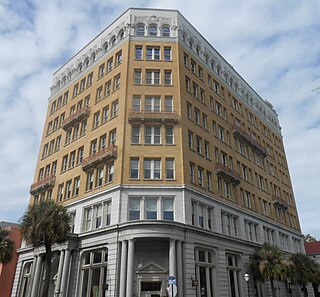
The People's Building at 18 Broad St. was Charleston, South Carolina's first "skyscraper", erected in 1910 and 1911 at a cost of $300,000. It was designed by a Swedish architect, Victor Frohling of Thompson & Frohling, of New York and built by both Simons-Mayrant of Charleston and also the Hadden Construction Co. Construction began on December 7, 1909. The pile driving so weakened a nearby residence that the People's Building & Investment Co. had to buy it. The structure is a steel framed building with iron framing whose engineer was D.C. Barbot. Work continued throughout early 1910. The construction of the building became a popular spectacle for residents to watch. An American flag was placed atop the building's frame when it was topped out in late April 1910. The owners of the building considered installing a rooftop garden to take advantage of the superb views from the building.

The James Simmons House is a late 18th-century house at 37 Meeting Street, Charleston, South Carolina which was, at one time, the most expensive house sold in Charleston. It was likely built for James Simmons, a lawyer. By 1782, it was home to Robert Gibbes, a planter. Louisa Cheves, a prominent antebellum writer, was born at the house on December 3, 1810. In 1840, Otis Mills, the owner of the Mills House Hotel, bought the house for $9,000. In October 1862, during the Civil War, the house was loaned to Gen. Pierre Beauregard, who used the house as his headquarters until August 1863. In 1876, Michael P. O'Connor, later a member of Congress, bought the house.
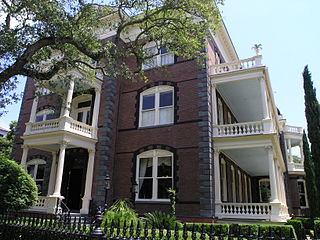
The Williams Mansion is a Victorian house at 16 Meeting St., Charleston, South Carolina. The mansion is open for public tours.

Vanderhorst Row in Charleston, South Carolina is a three-unit residential building built in 1800 by Arnoldus Vanderhorst, a governor of South Carolina (1792-1794). Each unit is four floors. The units at the north and south end of the range have doors along East Bay Street on the front in addition to doors on the sides of the unified building and exits to the rear. After the Civil War, the use of the building changed, and commercial purposes were installed. The building fell into disrepair before it was bought in 1935 by Josiah E. Smith for a restoration which cost $30,000. The architect for the restoration of the building was Stephen Thomas. The three units rented for $1500 to $1800 a year after the work was completed. As restored, each unit had a living room, dining room, kitchen, breakfast room, and pantry on the first floor; a drawing room, bedroom, and bath on the second; two more bedrooms on the third; and servants' rooms in the attic. For many years after the restoration of the building, the central unit was rented by the Charleston Club for its headquarters; the club relocated to 53 East Bay Street in 1958.

The Elias Vanderhorst House at 28 Chapel Street, Charleston, South Carolina, is a four-story mansion house which was built around 1835 as a home for members of the prominent Vanderhorst family of plantation owners.

The Rebecca Screven House in Charleston, South Carolina is Charleston single house built sometime before 1828 at 35 Legare Street.

The John Drayton House is a two-story wooden residence constructed on property that had been given by the state's first lieutenant governor, William Bull, to his son-in-law, John Drayton. The house was built, probably by John Drayton, some time after 1746 with alterations made in about 1813 and again in about 1900. Over time, the house has been attributed to different owners; during most of the 20th century, the house was credited to James Shoolbred, the first British consul in Charleston, with a construction date of about 1793.

The Philip Porcher House was built on what had previously been part of a 34-acre plantation located outside the city limits of Charleston, South Carolina. The lands passed to Isaac Mayzck and then, after his death in 1735, to his son, Isaac Mayzck II. The younger Isaac Mayzck gave land at the corner of Archdale and Magazine Streets to his daughter, Mary Mayzck Porcher, for her and her husband, Philip Porcher, to build a house. The house they built is similar to plantations of the time, built on a high foundation. Unlike similarly styled houses of the time, the house has two drawing rooms on the first floor rather than locating one on the second floor. Instead, there are four bedrooms on the second floor.

4
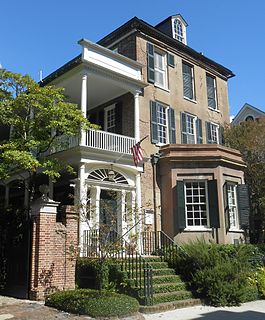
The Robert Pringle House is a historic house in Charleston, South Carolina.
Cabbage Row is a set of pre-Revolutionary buildings at 89 and 91 Church Street in Charleston, South Carolina. The buildings are most notable for having been the inspiration for "Catfish Row" in the DuBose Heyward novel Porgy and later the opera Porgy and Bess by Gershwin. DuBose Heyward had lived nearby on Church Street.
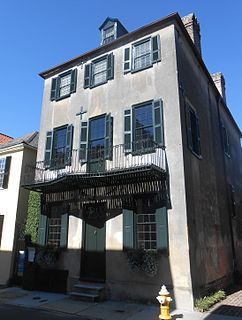
The William Vanderhorst House was used as the first post office in Charleston, South Carolina before 1753. Eleazer Philips was the first postmaster of Charleston to have a dedicated office for the handling of the mail, and he used 54 Tradd Street for that purpose. Earlier postmasters handled the mail in their own houses. The house was used as a post office until after 1791 when Peter Bacot relocated the operation to 84 Broad Street.

The Daniel Legare House is the oldest surviving house in the historic Ansonborough area of Charleston, South Carolina. The land upon which the house was built was sold to Daniel Crawford in May 1745 for a price that was much lower than expected for a house at the time, thereby suggesting a construction date after that time.
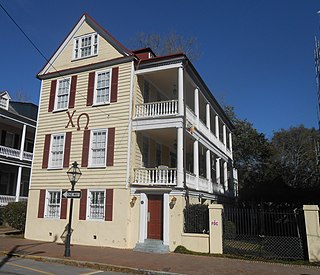
The John Scott House at 38 Coming Street is one of the two oldest buildings on the Charleston, South Carolina campus of the College of Charleston.

The John Edwards House in Charleston, South Carolina was built in 1770 by Colonial patriot John Edwards. During the Revolutionary War, half of the house was used by British admiral Mariot Arbuthnot as his headquarters, while the Edwards family was allowed to remain in the other half.
The John Schnierle House is an antebellum house in Charleston, South Carolina that was the home of Mayor John Schnierle.
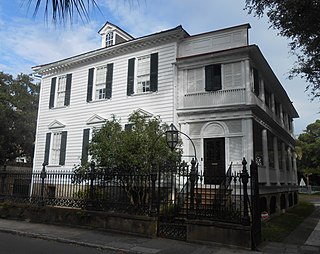
The Charles Elliott House is a pre-Revolutionary house in Charleston, South Carolina. Charles Elliott paid 2,500 pounds "current currency" for the property in 1764. Charles Elliott and his wife, Anne, were patriots during the Colonial period who maintained their family seat at Sandy Hill.

















